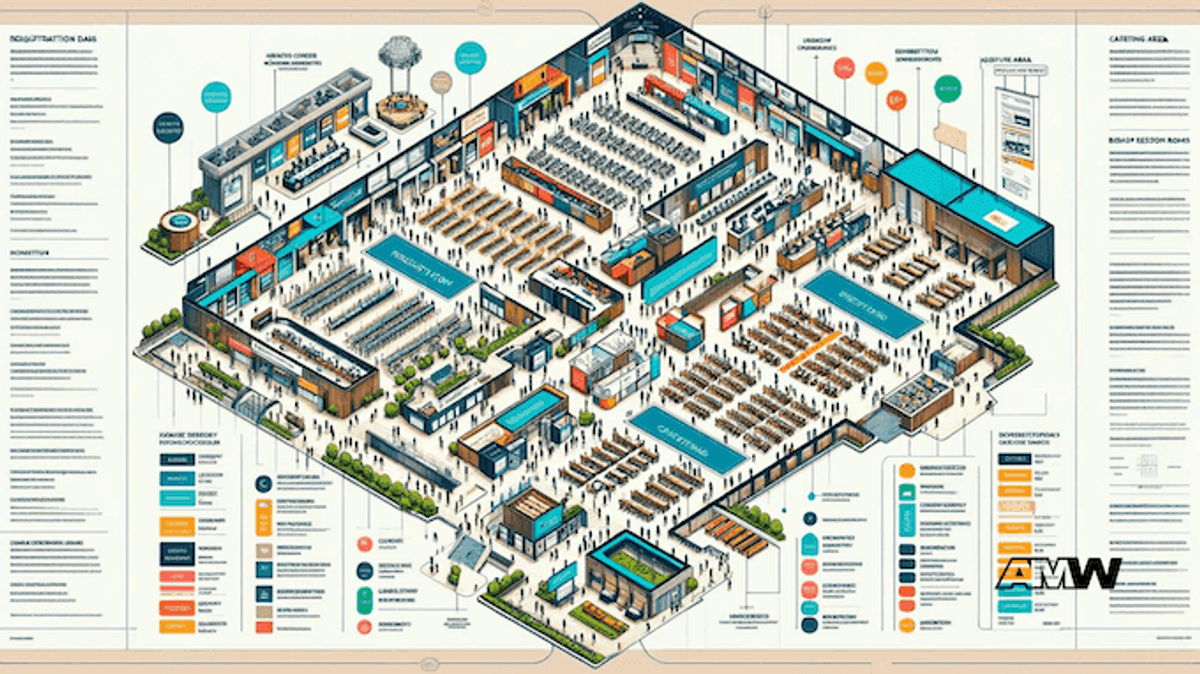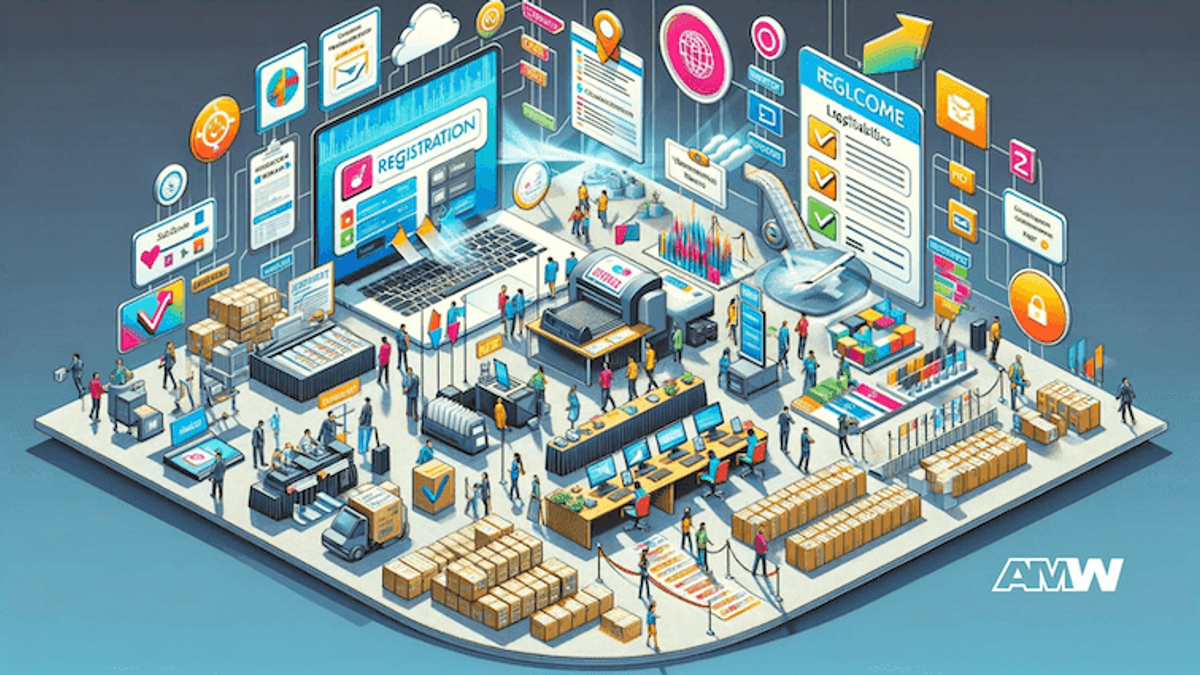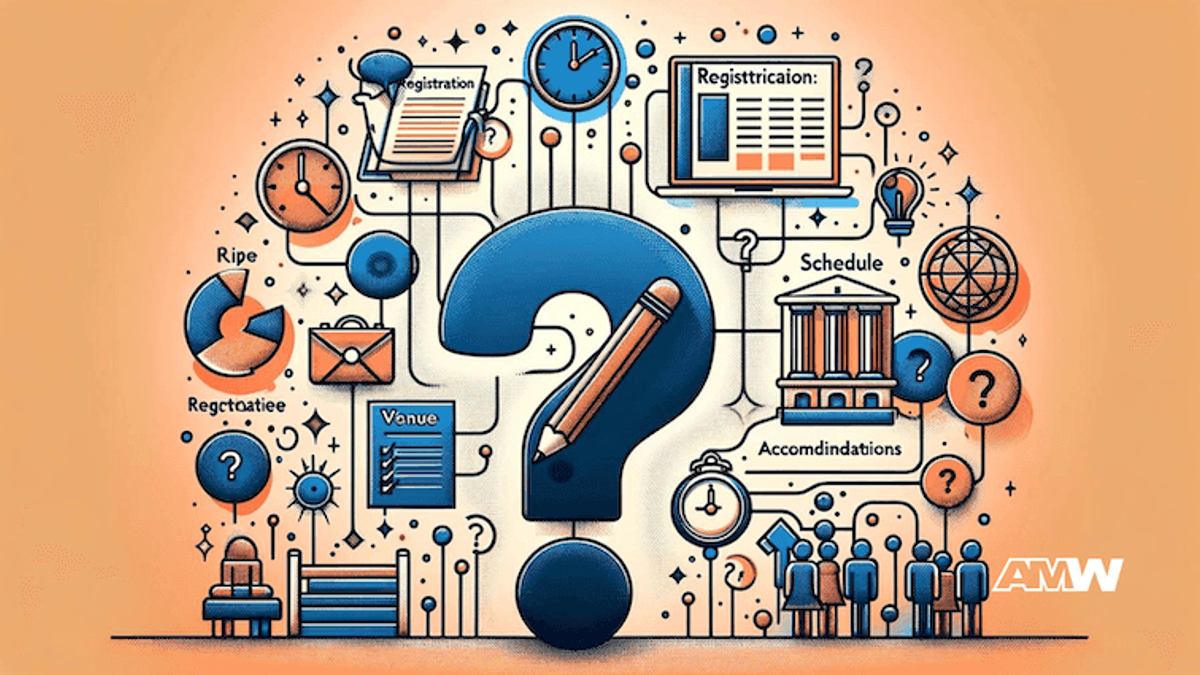How to Plan a Conference: A Step-by-Step Guide

Conferences are pivotal platforms for professional development, networking, and exchanging innovative ideas within various industries.
Quick Summary
Conferences serve as vital platforms for professional development and networking. Effective planning begins with defining the event's purpose and objectives, which guide all subsequent decisions. A dedicated team strengthens the event's execution, while a detailed budget ensures financial viability. Choosing the right venue and crafting an engaging agenda is essential in creating memorable attendee experiences. Finally, thorough marketing and attentive on-site management enhance the overall succ
Whether you're organizing a grand corporate event or a focused academic gathering, the essence of planning a conference lies in creating a memorable experience that enriches the lives of its attendees. Embarking on the conference planning journey can seem daunting at first. Yet, with the right approach, it becomes an incredibly rewarding endeavor that brings people together and fosters growth and inspiration among participants. This guide is crafted to assist you, the ambitious conference planner, through each stage of the conference planning process, ensuring your event runs smoothly and achieves its intended impact. From securing the perfect conference venue to selecting keynote speakers that resonate with your target audience, every detail contributes to the success of your conference.
So, let's set the stage for a successful event that will be remembered long after the last presentation files are closed and the final attendees depart.
Ready to Grow Your Business?
Get a free consultation and custom strategy tailored to your goals.
Step 1: Define Your Purpose and Objectives

The Cornerstone of Your Conference Plan
Before diving into the logistical whirlwind of conference planning, it's crucial to establish a solid foundation. This begins with a clear definition of your event's purpose and objectives. Whether the goal is professional development, networking, or showcasing groundbreaking research, understanding the main point of your conference will guide every decision you make, from the conference themes to the choice of keynote speakers.
Crafting Your Conference Planning Checklist
A comprehensive conference planning checklist tailored to your event's unique needs is invaluable. It should encompass different aspects of the event, including venue selection, technology requirements, and promotional strategies. Remember, a successful conference is not just about covering all necessary facilities; it's about creating an environment that fosters engagement and learning.
Identifying Your Target Audience
Knowing your target audience is paramount. This insight will shape the conference agenda, the choice of speakers, and even the marketing approach via channels like social media. A well-defined audience ensures that the conference features, such as networking opportunities with peers in the same industry, are aligned with attendees' expectations and professional interests.
Setting Measurable Goals
The objectives of your conference should be specific, measurable, achievable, relevant, and time-bound (SMART). Whether it's attracting a certain number of attendees, securing specific sponsors, or achieving a set level of attendee satisfaction, these goals will be benchmarks for the event's success.
Defining the purpose and objectives of your conference is the first crucial step in a series of actions that will bring your vision to life. This phase is not just about laying down the initial plans; it's about envisioning your conference's impact on its participants and the broader industry. With a clear direction and a dedicated planning committee, you're well on your way to organizing an event that will resonate with all your speakers, attendees, and potential sponsors. Keep this foundation in mind as we build the rest of your conference plan, ensuring that every element contributes to a cohesive, impactful, and ultimately successful conference.
Step 2: Build Your Team

Assembling Your Dream Team
The triumph of a conference heavily relies on the strength and dedication of its planning committee. Building a team of skilled individuals with unique strengths and expertise is crucial in bringing your vision for a successful event to life. Start by identifying the key roles required to cover all aspects of conference planning—from logistics coordinators to marketing experts, from content curators to technology specialists. Each member is vital in ensuring the event runs smoothly and meets its objectives.
The Importance of Diversity and Expertise
When assembling your team, diversity in skills and experience is essential. This variety ensures that all facets of the conference, such as selecting the right venue, attracting attendees, and incorporating the latest conference technology, are handled with expertise. Encourage collaboration among teams to foster a creative and productive planning environment.
Delegating Responsibilities
Effective delegation is key in the planning process. Assign tasks based on each member's strengths and areas of expertise. This could range from someone managing the conference website and online registration system to another focusing on securing keynote speakers and potential sponsors. Regular pre-conference meetings will help keep the team aligned on goals, progress, and possible obstacles.
Empowering Your Team
Empower your team by delegating authority and providing resources to solve problems. This empowerment accelerates the planning process and builds a sense of ownership and commitment among team members, driving them to strive for excellence in their respective areas.
Step 3: Budgeting

Laying the Financial Foundation
A well-thought-out event budget is the backbone of successful conference planning. Begin by listing all potential income sources, such as ticket sales, sponsorship packages, and exhibitor fees, alongside all expected expenses, including venue hire, speaker fees, promotional materials, and technology costs. This comprehensive overview will give you a rough idea of the financial scope of your event.
Managing Fixed and Variable Costs
It is important to comprehend the distinction between fixed and variable expenses. Fixed costs, such as the venue hire and keynote speaker fees, remain constant regardless of the number of attendees. In contrast, variable costs, such as attendee registration materials and catering, will fluctuate based on the final attendee count. Planning for both with precision is key to avoiding budget overruns.
Securing Sponsorship and Funding
Finding sponsors can significantly offset costs and enhance the conference experience. Start by identifying potential sponsors within the same industry or those who share the event's theme. Develop attractive sponsorship packages that offer value to sponsors, such as promotional exposure or opportunities to engage with conference attendees. A persuasive press release and targeted promotional materials can help attract sponsors and sell tickets.
Keeping an Eye on the Bottom Line
Regularly review and adjust the budget as plans evolve and more accurate cost estimates become available. Keep records of all financial transactions and agreements to ensure transparency and accountability. Remember, a successful conference is not only defined by its content and networking opportunities but also by its economic viability and sustainability for future events.
Final Reminders on Budgeting
Allocate a contingency fund for unforeseen expenses. This foresight ensures that your event can adapt to unforeseen challenges without compromising its quality or objectives. By meticulously managing the event budget, you lay a strong financial foundation that supports all other aspects of conference planning, ensuring your event is memorable and financially successful.
In these steps, the foundation for a great conference is built on a dedicated team and a well-managed budget. With these elements in place, you're well on your way to organizing an event that achieves its goals and leaves a positive impression on all attendees.
Step 4: Selecting the Venue

Finding the Right Venue for Your Conference
The venue you choose plays a pivotal role in the success of your event. It's not just a location; it's the backdrop against which your conference unfolds. Begin your search with a clear understanding of your conference's size, technological needs, and the atmosphere you wish to create. The right venue aligns with the event's theme, accommodates all your attendees comfortably, and possesses the facilities to ensure your event runs smoothly.
Key Considerations in Venue Selection
When planning a conference, consider the venue's accessibility for your target audience, including public transport options and parking availability. Evaluate the venue's capacity to host large plenary sessions and smaller breakout groups, ensuring it can support the varied dynamics of your conference schedule. Remember to assess the on-site or nearby accommodation options for attendees traveling from afar.
Negotiating with Venue Providers
Armed with your event budget and requirements, negotiate with potential venues. Discuss not just the rental cost but also the details of catering, audio-visual equipment, and Wi-Fi capabilities. Ensure the venue can support the right conference technology to facilitate a successful event. Flexibility and negotiation skills can lead to significant savings and added value.
Finalizing the Venue
Before making the final decision, conduct site visits to gauge firsthand the suitability of the venue. These visits are crucial for visualizing the event layout, understanding the flow between conference areas, and identifying potential issues. Once satisfied, secure the venue with a formal agreement, ensuring all key details are documented to avoid future misunderstandings.
Step 5: Planning the Programme

Crafting a Compelling Conference Agenda
The conference agenda is the heart of your event. It shapes your attendees' experience and influences your conference's overall impact. Identify topics that resound with your audience and industry. Select speakers, panels, and workshops that foster professional development.
Securing Speakers and Content
A successful conference features a mix of renowned keynote speakers and expert panelists who can engage and inspire the audience. Begin reaching out to potential speakers early, offering clear information about the event and what you hope they can contribute. It's recommended to use a combination of formats, such as interactive workshops and Q&A, to accommodate different learning styles and encourage active participation.
Building Networking Opportunities
Networking is a cornerstone of the conference experience, allowing attendees to connect with peers and industry leaders. Incorporate dedicated networking opportunities, such as coffee breaks, social evenings, and roundtable discussions, into the event schedule. These moments allow attendees to discuss ideas sparked by the day's sessions and build lasting professional relationships.
Leveraging Technology
Embrace the right conference technology to enhance the attendee experience. From mobile apps that provide real-time updates on the conference schedule to online platforms for attendee registration and engagement, technology can streamline logistics and add a modern touch to your event. Additionally, consider the potential for hybrid elements, allowing remote attendees to participate and expand your event's reach.
Final Thoughts on Programme Planning
The program is what will attract attendees to your conference, so invest time in curating content that is both informative and inspirational. Balance the needs and interests of your audience with the latest trends and discussions in your industry. Doing so ensures that your conference provides professional development opportunities and leaves a lasting impression on all who participate.
In these steps, selecting the perfect venue and planning an engaging program are crucial milestones in the conference planning process. With a great venue that meets all your needs and a carefully crafted agenda, you're well on your way to hosting a conference that attendees will remember as a pivotal moment in their professional journeys.
Step 6: Marketing and Promotion

Crafting Your Marketing Strategy
A successful conference requires a strategic marketing plan identifying the audience and the channels to reach them. Whether through social media, email campaigns, industry publications, or partnerships, each platform offers unique advantages to connect with potential attendees and generate buzz for your event.
Developing Promotional Materials
Create compelling promotional materials highlighting your conference's key features, such as the agenda, keynote speakers, and networking opportunities. Ensure your conference's theme is evident and engaging, enticing potential attendees to learn more. From eye-catching flyers to informative press releases, your promotional materials should reflect your event's professional and motivational nature.
Ready to Grow Your Business?
Get a free consultation and custom strategy tailored to your goals.
Utilizing Social Media
Social media is a tool to promote your conference and engage with your audience. Share regular updates, behind-the-scenes peeks, and speaker highlights to build excitement as the conference approaches. Encourage speakers and sponsors to share these updates with their networks, amplifying your reach. Hashtags specific to your conference can also help track conversations and increase visibility.
Leveraging Early Bird Registration and Special Offers
Offer early bird discounts or special packages for groups to encourage early registration. These incentives can significantly boost attendee numbers and provide early financial resources to help with planning. Additionally, consider creating special offers for returning attendees from your last conference to reward their loyalty and ensure continued participation.
Finalizing Your Marketing Efforts
As the conference date nears, intensify your marketing efforts to fill any remaining spots and keep the momentum going. An online survey can provide valuable feedback on your marketing strategy and help you adjust your approach for future events. Effective marketing fills seats, builds anticipation, and sets the stage for a successful conference.
Step 7: Registration and Logistics

Streamlining Attendee Registration
A smooth registration process is crucial for a positive first impression. Ensure your conference website is user-friendly and provides all necessary information for registration. Consider investing in conference technology to simplify this process, allowing easy attendee registration, payment processing, and confirmation.
Clear communication regarding registration details, accommodation options, and event schedules will keep potential attendees informed and engaged.
Planning for On-Site Logistics
The logistics of running a conference require meticulous planning to ensure everything from the venue setup to the event schedule operates without a hitch. Coordinate with your venue to finalize the keynote session layout, workshop, and networking areas.
Confirm that all necessary facilities, such as audio-visual equipment and catering services, are booked and detailed in your event's planning checklist.
Coordinating Speakers and Content
Ensure all your speakers are prepared and informed about the conference schedule and their respective sessions. Collect presentation files in advance and confirm any special requirements they might have. A pre-conference meeting with speakers can address last-minute details and ensure they feel supported and valued.
Final Preparations Before the Conference Starts
In the final days leading up to your conference, double-check every detail. Ensure that signage, attendee badges, and promotional materials are ready and that the registration area welcomes guests efficiently.
Conduct a final run-through with your dedicated team to address potential issues and confirm that everyone understands their responsibilities.
Ensuring a Memorable Experience
As the conference starts, focus on delivering a seamless experience for attendees. Every aspect of the conference should reflect your hard work and dedication from the moment they arrive, through each session they attend, to the final closing remarks.
Engage with attendees, gather feedback through an online survey, and use social media to keep the conversation going even after the event concludes.
By carefully marketing your conference and managing the intricate logistics of event planning, you set the stage for an enriching and successful conference.
These steps ensure that your event runs smoothly and lays the groundwork for future conferences that inspire and connect professionals across your industry.
Step 8: Execution and On-Site Management

Ensuring Smooth Operation on the Big Day
The day your conference starts marks the culmination of months of meticulous planning and preparation. Execution and on-site management are about turning your well-laid plans into action, ensuring the event runs smoothly from start to finish. Your dedicated team, each with their specific roles, becomes the engine that drives the conference's success, addressing any issues swiftly to maintain the seamless flow of events.
Coordinating with the Venue and Vendors
Communication is key during the execution phase. Ensure constant contact with the conference venue staff and external vendors to confirm that all logistical aspects, such as catering, audio-visual setups, and room configurations, are as planned. Regular check-ins will help anticipate and solve problems, keeping the event on track.
Managing the Conference Schedule
The conference schedule is the blueprint of your event. It's essential to monitor the timing of sessions closely, ensuring that everything runs according to plan, which might involve coordinating with keynote speakers and session leaders to manage their time effectively, facilitating transitions between different parts of the event, and ensuring that networking opportunities and breaks occur as intended.
Utilizing Conference Technology
Leverage the right conference technology to enhance the attendee experience and streamline management tasks. From real-time updates on the conference website to engaging with attendees and sharing key moments, technology can play an important role in keeping the planning committee and the attendees informed and engaged throughout the event.
Addressing Attendee Needs
The satisfaction of your conference attendees should be a top priority. Ensure clear signage for directions, readily available help desks for queries, and immediate responses to any feedback or concerns. The goal is to create an environment where attendees can focus on learning, networking, and enjoying the conference experience.
Step 9: Post-Conference Evaluation

Gathering Feedback
After the conference concludes, gathering feedback from attendees, speakers, sponsors, and your planning team is important. An online survey is a tool to get insights into what worked well and what could be improved. This feedback is invaluable for measuring the success of your event and guiding the planning of future conferences.
Reviewing Event Success Against Objectives
Revisit the objectives you set at the beginning of the conference planning process. Assess how well the event met these goals, from attendee numbers and satisfaction to engagement during sessions and networking events. This evaluation will help you quantify the success of your conference and identify areas for future growth.
Celebrating Successes and Identifying Lessons Learned
Take the time to celebrate the successes of your conference with your dedicated team. Recognizing the hard work and achievements of everyone involved is crucial for morale and motivation. Additionally, openly discuss the lessons learned, as these insights will be the foundation for improving future events.
Ready to Grow Your Business?
Get a free consultation and custom strategy tailored to your goals.
Planning for the Future
Use the post-conference evaluation as a springboard for planning future events. Consider how the feedback can shape your next conference's themes, format, and management. This continuous loop of planning, execution, and evaluation ensures that each event builds on the success of the last, allowing you to host conferences that meet and exceed the expectations of your target audience.
Final Thoughts
Executing a successful conference is a monumental task that requires dedication, flexibility, and a keen eye for detail. By following these steps for on-site management and post-conference evaluation, you ensure the smooth operation of your current event and lay the groundwork for future successes.
Remember, every conference is an opportunity to create an excellent experience for attendees, speakers, and sponsors, fostering professional development and connection within your industry.
Conclusion

Congratulations! You've journeyed through the comprehensive roadmap of conference planning, from initial concept to post-event evaluation. By now, you understand that to plan a conference is to embark on an adventure that, while challenging, is immensely rewarding.
The key to a successful conference is meticulous preparation, a dedicated team, and the ability to adapt and respond to unexpected situations.
Remember, the essence of a great conference extends beyond the venue, the speakers, or even the agenda. It lies in the experience you create for your attendees, the opportunities for professional development, and the connections forged within your industry.
The right conference technology, engaging keynote speakers, and a well-thought-out conference planning checklist are all integral to ensuring your event runs smoothly and resonates with your target audience.
As you reflect on this guide, consider it not just as a tool but as a source of inspiration for your next big event. Whether you're planning corporate events, academic gatherings, or industry-specific conferences, the principles of successful event planning remain the same. Stay motivated, clear your objectives, and always appreciate the power of a well-executed plan.
Here's to your next successful conference and the many more that will follow!
Frequently Asked Questions (FAQ)

- How do you plan a conference?Start with defining your event's purpose and objectives, assembling a dedicated team, developing a detailed budget, selecting the right venue, planning a compelling program, and executing a targeted marketing strategy. Follow through with efficient registration and logistics planning, ensure smooth execution and on-site management, and wrap up with a thorough post-conference evaluation.
- How far in advance should you plan a conference?Ideally, plan 12 to 18 months for large conferences to ensure ample time for venue booking, speaker recruitment, and marketing efforts.
- What are the four features of a successful conference?Engaging content, seamless logistics, active participation, and effective use of conference technology.
- What do you need to prepare for a conference?A comprehensive plan covering venue, speakers, marketing, attendee registration, logistical arrangements, and technology needs.
- What is an event conference?An organized gathering designed for individuals within a specific industry or with a common interest to discuss topics, share knowledge, and network.
- What should be on a conference checklist?Key details include venue booking, speaker lineup, marketing plan, registration system, logistic arrangements, technology setup, and post-event evaluation metrics.
- How do you plan a conference schedule?Align the schedule with your conference's goals, balancing keynote presentations, breakout sessions, networking opportunities, and breaks.
- What is the first step in planning for a conference?Clearly define your conference's purpose and set measurable objectives.
- What should be included in a conference program?Keynote speeches, panel discussions, workshops, networking sessions, and any special events relevant to the conference theme.
- How long does it take to prepare for a conference?The preparation time can vary widely depending on the event's scale, typically six months to over a year for larger conferences.
- What is conference planning?Organizing a conference involves logistical, financial, and promotional planning to ensure a successful event.
- What are the steps in organizing a conference?Identifying the event's purpose, building a planning team, budgeting, selecting a venue, planning the program, marketing, managing registrations and logistics, executing the event, and conducting a post-event evaluation.
This guide and the accompanying FAQs are designed to empower you with the knowledge and tools needed for successful conference planning. With each conference, you'll enhance your skills and contribute to your attendees' professional development and your industry's growth.
Happy planning, and here's to the remarkable experiences you're about to create!

Ready to Grow Your Business?
Get a free consultation and custom strategy tailored to your goals.